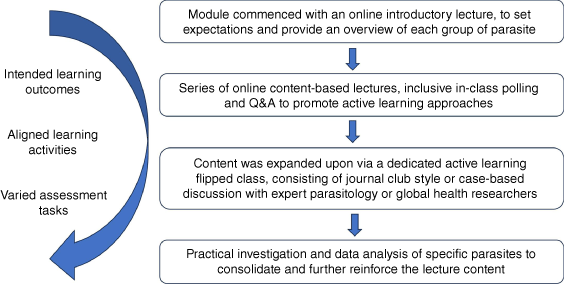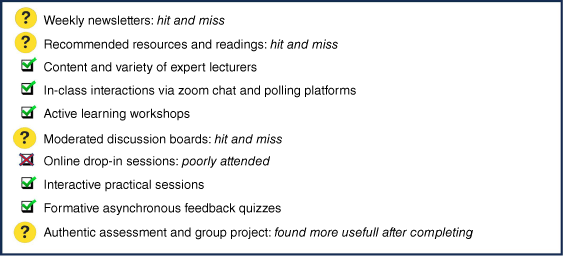Delivery of a bespoke parasitology subject in an alternative online realm: lessons and lasting innovations
Daniel T. W. Clarke A * , Abdul Jabbar B and Karena L Waller AA Department of Microbiology and Immunology, The University of Melbourne, The Peter Doherty Institute for Infection and Immunity, 792 Elizabeth Street, Melbourne, Vic. 3000, Australia.
B Department of Veterinary Biosciences, Melbourne Veterinary School, The University of Melbourne, 250 Princes Highway, Werribee, Vic. 3030, Australia.

Daniel Clarke is a Senior Lecturer in the University of Melbourne’s Department of Microbiology and Immunology. His previous research concentrated on the investigation of host–microbe interactions, particularly in terms of enhancing the immune response to better combat disease. Daniel now focuses on improving teaching practice to provide exceptional learning experiences for students. |

Abdul Jabbar is a Professor of Veterinary Parasitology at The University of Melbourne. His research interests are molecular and diagnostic parasitology, particularly epidemiology and virulence typing of parasitic infections. Besides research, Abdul is enthusiastic about improving parasitology teaching for veterinary and microbiology students, including the development of interactive digital teaching tools. |

Karena Waller is a Professor in the Department of Microbiology and Immunology, and Deputy Program Director of the Bachelor of Biomedicine at The University of Melbourne. Following 15 years in local and international malaria research, Karena now makes significant contributions to the teaching and learning of microbiology and immunology to Bachelor of Science and Bachelor of Biomedicine students. |
Microbiology Australia 44(3) 136-139 https://doi.org/10.1071/MA23040
Submitted: 29 July 2023 Accepted: 3 August 2023 Published: 29 August 2023
© 2023 The Author(s) (or their employer(s)). Published by CSIRO Publishing on behalf of the ASM. This is an open access article distributed under the Creative Commons Attribution-NonCommercial-NoDerivatives 4.0 International License (CC BY-NC-ND)
Abstract
In the second semester of 2020, despite the need to pivot to online learning in response to the COVID-19 pandemic, our academic teaching team commenced the delivery of a brand-new, bespoke parasitology subject to third year Bachelor of Biomedicine and Bachelor of Science students at The University of Melbourne. This purposefully designed subject, ‘Medical Microbiology: Parasitology’, was developed in collaboration with internationally renowned parasitologists and global health researchers to take a broad, multi-disciplinary approach to student learning and introduced students to the exciting, complex and diverse world of medically important parasites, including key examples of protists, helminths and arthropods. We also attempted to enhance the student experience during the online delivery of lectures, practical classes and active learning sessions by implementing synchronous and asynchronous approaches to increase engagement. This included weekly newsletters, in-class interactions by Zoom chat and polling platforms, moderated discussion boards, online drop-in sessions, authentic learning workshops and formative feedback quizzes. Although some engagement methods were not as successful as we had hoped, others proved to be instrumental in increasing supportive learning, as indicated by student attendance at online sessions, and the general sentiments observed from various student feedback mechanisms. Consequently, these strategies will continue to be incorporated as we shape the subsequent iterations of this, and other subjects, in a post-COVID world.
Keywords: constructivism, curriculum design, education-based teaching, innovation, multi-disciplinary, online learning, parasitology, student engagement, undergraduate education.
Introduction
Parasitic infections constitute a significant human health problem throughout the world. Yet prior to 2020, a bespoke parasitology subject was not available at The University of Melbourne for Bachelor of Biomedicine and Bachelor of Science students to study. Consequently, as the university and surrounding institutes of the Melbourne Biomedical Precinct had an array of internationally renowned parasitologists and global health researchers, this expertise was built upon to create a brand-new subject to be delivered in semester two of 2020. Initially, this purposefully designed curriculum endeavoured to highlight key microorganisms within the diverse world of parasites in an interactive, on-campus delivery mode; however, this was quickly reevaluated when the COVID-19 pandemic required a change to a wholly online format at the start of 2020. Pivoting required effective pedagogic design and thoughtful integration of opportunities in the curriculum to promote student engagement and active learning, which are increasingly seen as a prerequisite for effective and meaningful learning for science subjects,1 while also working to support student wellbeing in the online learning environment to enable student achievement. This was attempted by the incorporation of a combination of synchronous and asynchronous approaches to promote deep engagement and learning within the subject. Experiential learning sessions and authentic assessments were also included to reinforce student interaction as these have been shown to promote higher order thinking and allow students to use or apply knowledge and skills in meaningful real-life settings, including collaboratively online.2
Curriculum design and delivery
Medical microbiology subjects traditionally engage students in the exciting, complex and diverse world of clinically relevant microorganisms, including parasitic protozoa and helminths, as well as ectoparasitic arthropods that can cause direct disease or serve as disease vectors. In this newly designed subject, a similar approach was taken, concentrating specifically on medically important parasites through a broad, multi-disciplinary lens that integrated perspectives of microbiology, immunology, biochemistry, cellular and molecular biology, genomics, physiology, and epidemiology to examine host interactions and disease. Strong linkages were made to the impact on human health, particularly for those parasites that presented as notifiable diseases in Australia (cryptosporidiosis, malaria and zoonotic infections3), as well as neglected tropical diseases and important parasitic infections that affect human populations globally.
When designing new scientific subjects, a common practice has been to incorporate a teacher-focused approach where educators view their primary role as transmitting concepts or requisite knowledge to students.4 Although this may be instrumental to learning in part, the style is often best supplemented with active learning approaches to support a research-informed curriculum. Consequently, the curriculum of this subject was designed to align more with the theories of constructivism (and to some degree, student-driven collaboration through a connectivist approach online), with a further intention to be learning-centred by including a variety of application-based activities, such as tutorials and online laboratory-based sessions. This is extremely important in illustrating theoretical knowledge and extrapolation to practical application (covering all intended learning objectives), while also enabling the mastery of key concepts and skills at the conceptual level.5
The subject curriculum was designed to follow a well-structured, modular design (Fig. 1), which has been reported to promote better progression than traditional subjects (particularly in an online setting), as they foster a step-by-step learning approach that allows students to gradually develop skills and be assessed as they go.6 At the start of the COVID pandemic lockdown in 2020, other subjects at The University of Melbourne required a quick pivot to online only learning that involved content delivery by pre-recorded lectures, and this had some success, including in a veterinary parasitology class.7 Although this retained student learning and avoided possible network access issues during the live streaming of lectures, live synchronous sessions are thought to provide better opportunities for cognitive, social and teaching presence, as aligned with the learning theory of ‘community of inquiry’ in a blended learning setting.8 Consequently, each module in this newly designed subject was delivered online but in a live and synchronous manner, and consisted of four core elements: an introductory lecture to set the scene and raise the interest of the cohort, a series of content-based lectures (that were inclusive of active learning approaches), a dedicated active learning class that consisted of either in-class journal club style discussion of aligned recent or seminal publications, or in-class discussions with internationally renowned parasitology and global health researchers, and 3 h of practical content approximately every second week to complement the lecture content and previous discussions. Active-learning classes and practical or data analysis sessions were specifically designed to either allow students to more fully explore material or concepts introduced in the lectures, or to introduce and engage students to aligned material to expand their interest in the topic. This flipped classroom or blended learning approach helped to continually engage students with the material to support overall learning, and facilitated independent group discussion in small breakout rooms to create a more inclusive and collaborative environment for learning, as has been seen in other studies.9
Modular design for online learning of medical parasitology. Flow diagram indicates the constructive alignment of clear intended learning outcomes, core learning activities and online assessment tasks to facilitate student learning within each of the parasitic protist, helminth and arthropod modules.

When designing the assessment, the key driver was the constructive alignment of intended learning outcomes and learning activities with the assessment tasks. The associated intended learning outcomes followed effective criteria such as being assessable, active and comprehensible,10 and a mix of lower and higher order thinking verbs, as per Bloom’s revised taxonomy,11 was implemented to support this. The other main strength was to offer a variety of distributed assessment tasks across the teaching and examination period to purposefully support students in their learning across the subject, as well as reduce reliance on a high stakes end of semester exam. This included two online MCQ mid-semester tests, five online worksheets relating to practical material and a final online open-book MCQ + written answer exam. Students also completed a group project (four students per group) that involved the critical interrogation of an allocated research article, with authentic milestone assessment tasks completed throughout the semester, including a written research proposal, oral presentation of critical analysis and a final summary report of the described experimental outcomes. Distributed practice, interleaving, and spacing of these assessment tasks were used as key techniques to encourage learning and student performance, as supported by the literature,12 and the assessment was developed to be criteria-based, as this has been shown to increase educational effectiveness and reproducibility among multiple markers of assessment tasks where required.13
Online supportive learning strategies
Maintaining collaborative interaction and building a sense of community were some of the main challenges of delivering the subject wholly online. To try and overcome these potential educational pitfalls, we incorporated various online initiatives and opportunities to foster supportive learning. This included student interactions with academic staff to encourage connection and rapport through activities such as weekly online drop-in or casual chat sessions with lecturers and subject coordinators, opportunities for engagement and discussion with experts located outside of Melbourne (and Australia), in-class interactions by Zoom and polling platforms during online lectures, active learning classes and interactive practical sessions online, and formative asynchronous feedback quizzes to consolidate understanding. Furthermore, peer-to-peer teamwork opportunities were instated where possible, such as online breakout rooms in lectures and practical sessions for collaborative discussion through guided activities, as well as online discussion boards for asynchronous discourse of subject content and relevant items of interest. Students indicated an appreciation of synchronous, live lecture and practical sessions to allow engagement with the teaching team and fellow students, as well as having asynchronous opportunities for feedback and self-evaluation; however, other aspects were seen to have less effect (as indicated in Fig. 2).
Evaluation of supportive strategies used in the subject and lessons learnt. Several activities and approaches were used to overcome the challenge of online learning and while some were not as successful as hoped (as indicated by yellow question marks or red crosses), others were very effective in terms of student engagement and learning (as indicated by green ticks). Trends were evaluated from online University and in-house student feedback surveys, discussions with student representatives, and data obtained by subject site analytics and attendance records.

The less effective strategies were likely a consequence of two issues, namely the subject being newly developed and perhaps less resourced than was optimal (for online delivery of a brand new subject), as well as the further complication of ‘Zoom fatigue’, which affected online chats or online sessions (in what was the second consecutive semester of online delivery of teaching and learning in Melbourne), as participants needed to work harder and pay more attention to process verbal and non-verbal cues. As this form of learning takes a lot more energy and cognitive load,14 it may be indicative as to why extra-curricular activities such as online drop-in sessions were poorly attended. This sense of fatigue may be overcome by incorporating extra breaks during online sessions, providing opportunities for casual chats with lecturers within scheduled activities, or using other forms of communication such as asynchronous videos where appropriate.
Conclusion
By designing a student-centred subject, delivered by passionate parasitology and global health experts, loaded with opportunities for online engagement, feedback and support, students seemed to have thrived in their learning despite the online delivery mode, as indicated by participation levels and general feedback trends. It became clear that refinements could be made to our reading materials and assessment task instructions to better support learning and knowledge consolidation. However, based on educator evaluations, the active learning opportunities, collaborative activities, and online initiatives to foster supportive learning seemed to have been instrumental in promoting good student outcomes and a sense of community. These innovative approaches have continued to be incorporated into our subject as we subsequently moved through hybrid to face-to-face modes of delivery and will hopefully reinforce engagement as we promote further interactive aspects of learning in the future.
Acknowledgements
We thank all those who made contributions in evaluating and designing the content in this subject, including Michael Duffy, Stuart Ralph, Malcolm McConville, Aaron Jex, Rebecca Traub, Marshall Lightowlers, Neil Young and Clare Anstead.
References
1 Freeman S et al. (2014) Active learning increases student performance in science, engineering, and mathematics. Proc Natl Acad Sci USA 111, 8410-8415.
| Crossref | Google Scholar |
2 Herrington J et al. (2003) Patterns of engagement in authentic online learning environments. Australas J Educ Technol 19, 59-71.
| Crossref | Google Scholar |
3 Department of Health and Aged Care, Commonwealth of Australia (2023) Diseases on the National Notifiable Disease List. https://www.health.gov.au/our-work/nndss#diseases-on-the-national-notifiable-disease-list
4 Lueddeke GR (2003) Professionalising teaching practice in higher education: a study of disciplinary variation and ‘teaching-scholarship’. Stud High Educ 28, 213-228.
| Crossref | Google Scholar |
6 French S (2015) The benefits and challenges of modular higher education curricula. Issues and ideas paper, Melbourne Centre for the Study of Higher Education. https://melbourne-cshe.unimelb.edu.au/__data/assets/pdf_file/0006/2774391/Benefits_Challenges_Modular_Higher_Ed_Curricula_SFrench_v3-green-2.pdf
7 Jabbar A et al. (2021) Parasitology education before and after the COVID-19 pandemic. Trends Parasitol 37, 3-6.
| Crossref | Google Scholar |
8 Law KMY et al. (2019) Student enrollment, motivation and learning performance in a blended learning environment: the mediating effects of social, teaching, and cognitive presence. Comput Educ 136, 1-12.
| Crossref | Google Scholar |
9 Lage MJ et al. (2000) Inverting the classroom: a gateway to creating an inclusive learning environment. J Econ Educ 31, 30-43.
| Crossref | Google Scholar |
11 Krathwohl DR (2002) A revision of Bloom’s Taxonomy: an overview. Theory Pract 41, 212-218.
| Crossref | Google Scholar |
12 Cepeda NJ et al. (2008) Spacing effects in learning: a temporal ridgeline of optimal retention. Psychol Sci 19, 1095-1102.
| Crossref | Google Scholar |
13 Sadler DR (2005) Interpretations of criteria‐based assessment and grading in higher education. Assess Eval High Educ 30, 175-194.
| Crossref | Google Scholar |
14 Bailenson JN (2021) Nonverbal overload: a theoretical argument for the causes of Zoom fatigue. Technol Mind Behav 2, 1-6.
| Crossref | Google Scholar |


